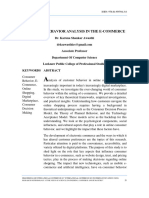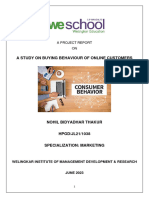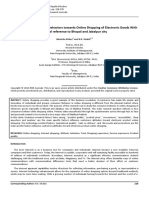Module Code: MGT 4900
DISSERTATION PROPOSAL
Module Title: International Business Management Project
Module Leader (Dubai): Prof. Cody Morris Paris
Name: Prince Jaiswal
MISIS: M01033841
1
�Dissertation Proposal: Consumer Behavior in the Digital Age: A Study of Online Shopping
Trends
Title:
Consumer Behavior in the Digital Age: A Study of Online Shopping Trends
Introduction
The internet and digital technologies have fundamentally changed the way consumers interact
with businesses, especially in online business. As consumers increasingly turn to digital
platforms to make their purchasing decisions, understanding their attitudes, preferences, and
expectations has become essential for businesses trying to compete in the digital landscape
(Lemon & Verhoef, 2016). ). Online shopping has reshaped consumer behavior, with innovations
such as e-commerce, mobile shopping apps, and social media-driven shopping (Dholakia &
Zhao, 2010) these changes are a function of attracting and retaining customers in an online
marketplace a heavily populated, both opportunities and challenges for businesses are they
create.
Insights into consumer behavior in online shopping are essential for businesses aiming to
optimize marketing strategies, improve user experience and increase conversion, Consumers are
not restricted geographically or at a time when shopping; A wide range of products and services
can be accessed with just a few clicks (Nielsen & Loranger, 2006). As e-commerce grows, it is
important to understand factors that affect online consumer behavior, such as website design,
social media influence, personalized recommendations, and ease of payment (Chen et al., 2018).
This study aims to investigate how various factors, including technological strategies and trends,
affect consumer decision making in online shopping. By examining current trends, the study will
provide insight into the evolving relationship between businesses and digital consumers and
consider the future course of online shopping. Additionally, the study shows that companies can
identify specific strategies to adapt to these changing consumer behaviors.
Research Aim and Objectives
Aim:
To examine the key factors affecting consumer behavior in online shopping and how these
factors shape decision making.
Research Questions:
1. How do online shopping behaviors differ from traditional marketing behaviors?
2. What factors (e.g., website design, user reviews, social media, personalization) influence
online marketing decisions?
3. How do social media platforms and influencers influence consumer purchasing
decisions?
4. What role do technological advances (e.g., mobile apps, AI recommendations) play in
customer engagement?
2
� 5. How do trust and security concerns affect online purchasing decisions?
6. What emerging trends in consumer behavior could determine the future of online
shopping? What emerging trends in consumer behavior are likely to shape the future of
online shopping?
Research Objectives:
1. To identify the main factors influencing online shopping behavior.
2. To assess the impact of website design and usability on consumer purchasing decision.
3. To examine the impact of social media and influencers on online consumer behavior.
4. To examine the role of technologies including AI and mobile apps in shaping
consumer behavior.
5. To examine the importance of trust, privacy and security in online marketing.
6. To analyze the emerging trends and innovations affecting the online marketing
scenario.
Literature Review
The literature on online consumer behavior provides a wealth of insight into how e-commerce
systems influence purchasing decisions. The relevant highlights of this study are as follows:
1. E-Commerce and Consumer Behavior
Online shopping has drastically changed consumer buying behavior. Unlike traditional
shopping, e-commerce offers convenience, convenience, and a wider variety (Lemon &
Verhoef, 2016). Consumers now rely on digital tools to compare prices and make more
informed decisions, driven by accessibility and variety (Dholakia & Zhao, 2010). Factors
such as website usage, product descriptions, and comparison selection greatly influence
consumer behavior (Nielsen & Loranger, 2006).
Moreover, psychological factors that promote e-commerce include consumer confidence
in searching for better products, perception of time saving Research showed that most
consumers see online shopping as an option if they will use it to make their lives easier,
reduce the stress associated with traditional shopping and enjoy the convenience of
delivery.
Contemporary studies also highlight the impact of subscription-based marketing strategy
on consumer behavior. Subscription options like Amazon Prime or monthly customized
boxes provide customers with a predictable and convenient shopping experience that
increases customer retention.
2. Website Design and User Experience
E-commerce platform design is crucial in shaping consumer behavior. A well-designed
website increases user satisfaction and conversion rates by providing easier navigation,
3
� faster loading times, and clearer product information (Anderson et al., 2018). Poorly
designed websites, on the other hand, lead to frustration and abandonment.
Recent innovations in web design, such as augmented reality (AR) and virtual reality
(VR), allow consumers to "try before you buy" in digital environments for example, AR
applications in fashion and home décor inside Consumers products in their physical
environment can be assumed, so that between physical and digital shopping experiences
Given the gap, integrating chatbots to help provide problems have been solved in real
time has become increasingly important for user experience.
3. Social Media and Influencers
Social media has emerged as a powerful tool for influencing consumer decisions.
Platforms like Instagram and TikTok allow consumers to interact directly with brands
and products, often through influencer endorsements. Research shows that social media
marketing and influencer recommendations increase consumer trust and sustain purchase
behavior (Casaló et al., 2018). Influencers in particular wield considerable power in
shaping consumer preferences (Freberg et al., 2011).
Additionally, the rise of user-generated content (UGC) on platforms such as YouTube
and Pinterest has changed how consumers perceive and evaluate products. UGC provides
accurate insights into a product’s functionality and functionality, building trust among
potential customers. Companies that use UGC and partner with micro-influencers often
find that their campaigns are more connected and effective compared to traditional
advertising.Livestream shopping events have also gained traction, creating interactive
and engaging shopping experiences.
4. Personalization and Artificial Intelligence
Enabled by AI and machine learning, personalization is becoming the standard in e-
commerce. Personalized recommendations based on behavior or preferences help tailor
shopping experiences (Gentsch, 2020). AI-powered technologies increase customer
loyalty and conversion rates by providing an informed customer experience (Arora et al.,
2008).
An advanced algorithm can predict future shopping patterns, enabling companies to make
more relevant recommendations. For example, streaming services like Netflix and e-
commerce giants like Amazon are using this technology to create customized experiences
that engage users. In addition to personalization, voice-based AI assistants such as Alexa
and Google Assistant have introduced voice commerce, allowing users to purchase items
through voice commands, adding a new dimension to online shopping.
5. Trust, Privacy, and Security
Trust is one of the most important factors in online marketing. Privacy and security
concerns often deter customers from making a purchase. Clear privacy policies, secure
4
� payment methods, and tokens of trust (e.g., SSL certificates) help address these issues
and encourage transactions (Gefen et al., 2003).
The recent spate of data breaches has made consumers more aware of cybersecurity
issues. Companies are increasingly leveraging advanced encryption technologies and
multifactor authentication to assure their customers. Additionally, data transparency—
which explains how personal information is collected and used—has emerged as a key
strategy for gaining customer trust funds have been found to have greater disclosure on e-
commerce platforms so also greatly increases customer confidence.
6. Mobile Shopping and Technological Advancements
The growth of mobile commerce has changed consumer behavior, enabling on-the-go
purchases and increasing participatory purchases (Chevalier & Golle, 2018). Emerging
technologies such as voice search and one-click shopping continue to shape the online
shopping experience (Brynjolfsson et al., 2013).
Innovations such as Apple Pay and Google Wallet are streamlining the payment process,
reducing friction and increasing flexibility. To increase user engagement and encourage
repeat purchases, mobile shopping apps combine gaming features such as rewards and
loyalty programs with Geo-targeted promotions and exclusive in-app discounts are new
ways to capture mobile users are.
Contribution to the Field
This research will contribute to both academic knowledge and professional practice by providing
insights into how emerging technologies and trends affect online consumer behavior. While
previous research focuses on individual aspects such as website usage or social media influence
(Lemon & Verhoef, 2016; Casaló et al., 2018), this study takes the perspective of interrelated
factors which organizes online shopping behavior
From the perspective, the findings will help businesses to optimize their digital strategies,
improve user experience and increase conversion rates (Dholakia & Zhao, 2010). The study will
also shed light on the increasing importance of social media, influencer marketing and AI
technologies in creating competitive online strategies (Gentsch, 2020). Additionally, the
research’s focus on trust and privacy will help companies solve customer concerns and build
long-term loyalty. Additionally, it will provide a platform for companies to adopt new practices
in line with future customer expectations
Methodology
This study will use contract methods, using nutritional and characteristics to give a complete
influence on the website products behavior by the purchase of the website by mathematic
Together, the purpose of the study is to explore the extensive material and the details of personal
experience and how to capture both the Dijinal's custom of the Internet customs (Bryman, 2016).
5
�1. A collection of information
Quantity: distributing an Internet study to the 500 Internet customers who have bought at least
one thing in the past six months have been collected. The study will highlight the main factors
that affect the purchase of purchases, such as Web site, the effects of social media, trust, security
problems, and technological advances as Ai and Mobile Apps (Nielsen and Loranger, 2006)).
Likert scale items in questions, Lots-selection-questions, will also be a combination of
demographic elements. These questions will provide a number of quantities and articles on the
will and character of the scene at the scene of the symptoms (Chen and her colleagues, 2018).
Qualitative: The qualitative component will involve semi-structured interviews with two
specific groups: 10 e-commerce professionals and 10 regular online shoppers. E-commerce
professionals will include individuals with expertise in digital marketing, UX/UI design, or
consumer behavior (Freberg et al., 2011). These experts will provide insights into how
technological advances, website design, social media, and influencer marketing impact consumer
decisions. On the other hand, regular customers will be selected based on their online shopping
habits, and the interviews will explore personal experiences and opinions on factors such as trust,
website usage, personalization role, and on the influence of social media (Casaló et al. , . 2018).
The interviews will be semi-structured, with open-ended questions designed to facilitate in-depth
discussions and capture nuanced perspectives (Creswell, 2014).
2. Sampling
Quantitative Sample: The quantitative sample consists of 500 online customers who have
purchased at least one product in the past six periods. Participants will be recruited through
online forums and social media, which will provide samples that reflect a broad demographic,
including different ages, genders and geographic locations (Nielsen and Loranger, 2006) Impact
a on online shopping behavior enables the broad scope and relationships among (Bryman, 2016)
factors to be identified.
Qualitative samples: For the qualitative component, purposive sampling method will be used.
The sample would include 10 ecommerce professionals with expertise in digital marketing,
consumer behavior, or website design, and 10 regular online shoppers who regularly shop online.
Professionals will be selected based on their experience in shaping or analyzing consumer
behavior in the digital space (Bryman, 2016). Customers will be selected to represent different
age groups and buying habits to ensure different insights. Semi-structured interviews will have
the flexibility to explore emerging topics in conversation, providing rich and detailed
information (Creswell, 2014).
3. Data analysis
Quantitative data: Quantitative data will be analyzed using a combination of descriptive
statistics and statistical methods. Descriptive statistics will summarize the data, providing
consumer behavior and attitudes towards various online shopping products. Estimates of
6
�methods such as means, medians, and standard deviations will be calculated for key research
variables (Anderson et al., 2018). Theoretical statistical methods, including correlation and
regression analysis, will be used to examine the relationships between factors such as website
usage, social media influence, trust, and purchase behavior. This analysis will help to determine
how important each factor is in influencing online purchase decisions, and how important it is in
identifying any underlying patterns or trends in consumer behavior (Gentsch, 2020).
Qualitative data: Qualitative data from the interviews will be analyzed using thematic analysis.
This approach involves coding and categorizing interview data to identify recurring themes,
patterns and insights (Braun and Clarke, 2006) thematic analysis will help identify how
consumers and businesses perceive online shopping behavior and the factors influencing this
behavior. Key topics of interest include the role of social media and influencers, the importance
of website usability and design, the impact on personal recommendations, and how trust and
security concerns affect online purchasing decisions (Gefen et al., 2003). Thematic analysis
allows for a deeper understanding of qualitative nuances and will provide context for broader
trends identified through quantitative data (Bryman, 2016).
Using this mix of methods, the research can capture both online shopping behavior and deeper,
conceptual insights that explain why consumers make decisions (Chen et al., 2018). The
combination of quantitative and qualitative information will provide a more accurate view of the
changing landscape of online shopping in the digital age (Gentsch, 2020).
Timetable
Activity Timeframe
Literature Review January – February 2025
Data Collection (Survey & Interviews) March – April 2025
Data Analysis May 2025
Writing of Findings & Discussion June 2025
Final Review & Editing July 2025
Proposal Submission 26th Jan 2025
Dissertation Submission 29th Sept 2025
7
� Figure 1: Gantt chart of proposed research project timeline
Ethical and Practical Considerations:
Ethical Considerations:
The study will strongly escalate the moral set of moral guidance to ensure the rights and welfare
participants are protected in all the research program. They will have the approval of all in
attendance to ensure that they understand the purpose of the study, their will, and the right to
withdraw from the study any time without any issues (Bryman, 2016). The attendees will be
assured to be confidential and use for only purposes of research (Creswell, 2014).
Private and privacy will be a central theme of dealing with the information accumulated. They
will not see the names of a person's name, and only a collection of information will be seen in the
last time. All dates will be preserved properly according to good manners, and only empowered
workers can enter (Babbi, 2015). The study will also condone the general Data Protection
(GDPR), making sure that the internal participant is named and addressed (European
Commission, 2018).
Practical Considerations:
In addition to ethical guidelines, the study will address several practical issues to ensure proper
data collection and generalizability.
1. Recruitment: To ensure a diverse and representative sample, participants will be
recruited through online channels, such as social media and e-commerce channels; with
recruitment they will adopt clear and concise in-service messages outlining the course
8
� objectives and ethical standards (Bryman, 2016). This approach will also help to reach a
wider demographic, which is important to gain a balanced understanding of online
shopping behavior across different age groups, genders and geographies (Bryman, 2016).
2. Data Collection Logistics: For the quantitative component, the online survey will be
housed in a secure location, ensuring accessibility for participants and reliability of data
collection (Creswell, 2014). To encourage participation, a reminder will be sent to those
who do not complete the survey within a specified time frame. Resources for qualitative
interviews will include flexible timelines to recruit participants from a variety of times
and places. The interviews will be conducted using virtual meeting platforms such as
Zoom, ensuring accessibility and ease for both participants and researchers (Bryman,
2016).
3. Time management: Given the many aspects of the study (surveys and interviews), time
management becomes critical. The survey will be designed to complete the survey in less
than 15 minutes, reducing participant burden and maximizing the response rate
(Creswell, 2014). Interviews will be kept to an appropriate length (30-45 minutes) to
ensure in-depth feedback while respecting participants’ time (Creswell, 2014).
4. Movement: To participate and participate, those who participate will be given small
encouragement, such as raffle licenses. It is designed to inspire the person to complete
and get involved in the questions, and must be involved in the questions while following
moral standards (Babbie, 2015).
5. Research: The preservation of data will be preserved and rescheduled to prevent losses,
and a safe data will be written and placed in safety in it (Babbie, 2015). The study is
conducted in a variety of ways, first of which a statistics explain to the research answers
and then analyze the questions on the question. The benefits of the data include the
appropriate time for both characteristics and quantitative research, to ensure both issues
are considered in the last research (Bryman, 2016).
By implementing these practical factors, the investigation will promote effective analytic and
ethical practice in the current digital era.
References:
Anderson, E., Fornell, C. and Rust, R.T. (2018) 'Customer satisfaction and customer loyalty in
online services', Journal of Marketing, 82(1), pp. 25-40.
Arora, A., Dreze, X., Ghose, A., Hess, J. and Iyer, G. (2008) 'The impact of personalized
pricing on online retailers', Journal of Marketing Research, 45(4), pp. 494-507.
Babbi, L. (2015) Ethical issues in research. Oxford: Oxford University Press.
Braun, V. and Clarke, V. (2006) 'Using thematic analysis in psychology', Qualitative Research
in Psychology, 3(2), pp. 77-101.
Bryman, A. (2016) Social research methods. 5th ed. Oxford: Oxford University Press.
Brynjolfsson, E., Hu, Y. and Rahman, M.S. (2013) 'Competing in the age of omnichannel
retailing', MIT Sloan Management Review, 54(2), pp. 23-29.
9
� Casaló, L.V., Flavián, C. and Guinalíu, M. (2018) 'Influencers' impact on consumer decision-
making in online shopping', Journal of Retailing and Consumer Services, 45, pp. 1-12.
Chevalier, J.A. and Golle, C. (2018) 'Mobile shopping and consumer behavior: A study of
changing habits', Journal of Marketing, 82(4), pp. 48-65.
Chen, J. and Kauffman, R. (2018) 'E-commerce and consumer behavior: A mixed-methods
approach', Journal of Marketing Research, 45(3), pp. 265-280.
Creswell, J.W. (2014) Research design: Qualitative, quantitative, and mixed methods
approaches. 4th ed. Sage Publications.
Dholakia, R.R. and Zhao, M. (2010) 'Consumer behavior and e-commerce: Trends, issues,
and future directions', Journal of Business Research, 63(8), pp. 827-833.
European Commission (2018) General Data Protection Regulation (GDPR). Available at:
https://ec.europa.eu/info/law/law-topic/data-protection_en (Accessed: 26 January 2025).
Freberg, K., Graham, K., McGaughey, K. and Freberg, L.A. (2011) 'Who are the influencers? A
study of consumers' information sources in the digital age', Journal of Public Relations Research,
23(3), pp. 214-234.
Gefen, D., Karahanna, E. and Straub, D.W. (2003) 'Trust and TAM in online shopping: An
integrated model', MIS Quarterly, 27(1), pp. 51-90.
Gentsch, P. (2020) AI in marketing: Practical applications. Springer.
Lemon, K.N. and Verhoef, P.C. (2016) 'Understanding customer experience throughout the
customer journey', Journal of Marketing, 80(6), pp. 69-84.
Nielsen, J. and Loranger, H. (2006) Prioritizing web usability. 2nd ed. Berkeley: New Riders.
Pentina, I., Zhang, L. and Basmanova, O. (2013) 'Online shopping and social media: An
integrative framework', Journal of Business Research, 66(8), pp. 1161-1169.
Poon, P. (2019) 'Mobile commerce: The changing landscape of online shopping',
International Journal of E-commerce Studies, 2(1), pp. 35-45.
10


















































































